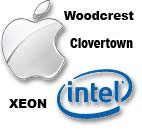 Steve Jobs is a loose cannon. At least in the eyes of his peers. They don’t really like him. They can’t seem to run their company like good ole Steve does or at least the way that they want to run it.
Steve Jobs is a loose cannon. At least in the eyes of his peers. They don’t really like him. They can’t seem to run their company like good ole Steve does or at least the way that they want to run it.
You see, Steve has a track record. A record of success. Let’s take a look over the past few years:
- G4 “Snowball” iMac
- G4 Titanium PowerBook Notebook
- G4 Aluminum PowerBook Notebook
- G4 Mac Mini
- G5 iMac
- G5 PowerMac Tower
- G5 Quad Core PowerMac Tower
- Intel Mac Mini
- Intel MacBook Pro Notebook
- Intel MacPro Tower Woodcrest Dual Core 64bit XEON
Not to mention the 5 Generations of iPods:
- iPod
- iPod Mini
- iPod Photo
- iPod Shuffle
- iPod with Video No up to 80 gigs
- iPod Nano Now up to 8 gigs of flash ram
Everyone of these devices have been met with incredible success. No doubt. But the change that we have to watch now is the transition to Intel processors. Namely, the 64 bit dual core offerings: Dual Core Xeon (Woodcrest) and the new Quad-Core Xeon (Clovertown). Althought the 32 bit Core Duo and Core 2 Duo are a significant shift for Apple, the Xeon processors are my focus here.
Anandtech had this to say (for the full article What About Quad Core ):
We grabbed a pair of 2.4GHz Clovertown samples and tossed them in the system, and to our pleasure, they worked just fine. Our
samples used a 1066MHz FSB, although we’re expecting the final chip to use a 1333MHz FSB, but the most important part of the test
is that all 8 cores were detected and functional.
While they are under an NDA, they could not reveal any benchmarks.
The Cloverton Quad Core processors are pin compatible with the Woodcrest. And this is why Apple move to Intel instead of AMD.
Steve Jobs is a methodical, detail oriented CEO. I am very sure that he spent months looking very carefully at both roadmaps for Intel and AMD for the long term, but more importantly, the short term.
Why short term? Because Apple was having a very difficult time getting processors from G5 processors IBM. IBM was also dragging their feet on speed bumps. Apple needed to up it’s processors now. AMD may have had a short term solution but the long term outlook was not as uplifting as Intel’s road map. Apple need the processors now. In large quantities. And they need a for sure upgrade path to more advanced chips without having to completely redesign the main logic board, again and again. As what would be the case with each successive AMD processor. The Cloverton gives Apple and edge in
that they can use the same motherboards in the new Xeon Xserves and MacPro’s. Or at least this is the assesment by Anandtech. As is mine.
We have heard for some months about the immergence of a MacPro Extreme. A pro-workstation class Mac (finally). I believe that to be a Dual Quad Core Cloverton based MacPro. 2×4. 8 cores. 8 processors. In a Mac. There may also be a line of high-end rack based servers (Xserve Extreme). Possible s 2 or 3 rack space Dual Quad Core Clovertons. I’m starting to dream now. But I can dream can’t I.
Along with these rumors of the Extreme line of machines is the rumor of Apple acquiring Sun Microsystems. Not necessarily for their product line but for their in-roads into corporate American server/workstation market. What a pairing. Two of the most powerful OSes on the planet: OS X and Solaris. Both Unix based brick houses. Both number crunching monsters. I can hear the Mac sites now. Churning out info on the new Big Mac II cluster super computer.
I could go on for days writing about whot could be. But as Tuesday, September 12, 2006 reminds us. Steve doesn’t show all of his cards at once and he does not cater to the rumor mill. I guess we will have to see what happens in January at MacWorld.

